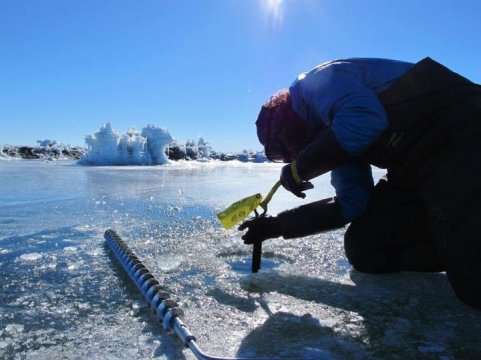[ad_1]
Stay overnight on an Antarctic ice shelf, and you may feel the shaking from thousands of tiny quakes as the ice re-forms after melting during the day.
In a recent study, UChicago scientists placed seismometers on the McMurdo Ice Shelf and recorded hundreds of thousands of tiny “ice quakes” that appear to be caused by pools of partially melted ice expanding and freezing at night. The phenomenon may be able to help scientists track glacier melting — and to help explain the breakup of large ice shelves.
“In these areas we would record tens, hundreds, up to thousands of these per night,” said study co-author Douglas MacAyeal, a professor of geophysical sciences and renowned glaciologist who has been traveling to the Antarctic to study the behavior of ice and snow for decades. “It’s possible that seismometers may be a practical way for us to remotely monitor glacier melting.”
Climate change is causing the Antarctic to melt, but glaciologists are still mapping how, where and why. There is much we still don’t understand about the process — as evidenced by the massive Larsen B ice shelf collapse in 2002, which took glaciologists by surprise — and understanding these mechanisms is key to predicting the future for the ice.
MacAyeal and the team were interested in the role of “quakes” on the floating ice shelves. (You may remember reports of ice or frost quakes around Chicago and the Midwest during the cold snap caused by the polar vortex weeks ago, when residents reported booms or cracking sounds at night; this is the same mechanism.) But they wondered how often the phenomenon was occurring in ice in the Antarctic, and what role it might play in the melting and breakup of ice.
The team set up seismometers for 60 days during the melt season in two locations near seasonal meltwater lakes on the McMurdo Ice Shelf. One was drier; the other was slushier, with pools of melted water forming and refreezing. The wetter location, they found, was alive with seismic activity at night.
“In these ponds, there’s often a layer of ice on top of melted water below, like you see with a lake that’s only frozen on top,” MacAyeal explained. “As the temperature cools at night, the ice on the top contracts, and the water below expands as it undergoes freezing. This warps the top lid, until it finally breaks with a snap.”
The energy vibrates out into the surroundings, where it’s picked up by seismometers. Some of the cracks re-heal, but some do not, MacAyeal said.
It may explain why icebergs actually break off more frequently during colder times of the year. “Perhaps this is happening at longer, slower scales,” MacAyeal said.
The discovery adds an important piece to our understanding of the physics and processes around melting ponds on ice shelves — especially if it can help researchers remotely keep track of Antarctic melting. “It may be very useful to add this to our other ways of monitoring ice,” MacAyeal said.
UChicago scientists Jinqiao Lin, Becky Goodsell and Grant Macdonald co-authored the study. Other researchers on the study were Alison Banwell and Ian Willis with the University of Colorado Boulder and the University of Cambridge, and Emile Okal with Northwestern University.
Story Source:
Materials provided by University of Chicago. Original written by Louise Lerner. Note: Content may be edited for style and length.
[ad_2]















